Pshekhiba raspberry variety
The gardeners and summer residents did not have time to discuss, receive and plant the long-awaited Radzeeva and Sokolitsa, and Polish breeders from Brzezna amazed everyone again. Pshekhiba, like a bright comet, swept across the crimson sky and became one of the most discussed novelties. And again a variety with an incomprehensible name for us, from the so-called "mountain series". Pshekhiba (Prehiba, Pshechiba, and originally Perehyba) is a mountain peak (1173 meters) in the western part of the Radziev ridge, in the Sondetsk Beskids (a system of mountain ranges in the western part of the Carpathians). The name itself means "pass". This easily accessible, scenic spot is included in many hiking and cycling routes and is the starting point. At the top is a popular hotel built in the late 1940s and an 87-meter TV and radio tower.
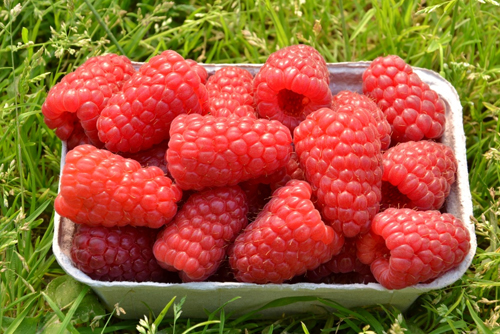
The variety is very young. In Poland, farmers began to plant it in 2015. On the market of planting material in Ukraine, Russia, Belarus, it became available for free sale only in 2017. Therefore, our gardeners are just beginning to form an objective impression about this raspberry. But even now, taking into account the Polish experience, we can say that we have this variety "seriously and for a long time." And what exactly is Pshekhiba interesting - about this in our article below.
History of creation
The summer variety Przehyba comes from Sadowniczym Zakładzie Doświadczalnym Instytutu Sadownictwa i Kwiaciarstwa in Brzezna, Poland. Bred by Polish breeders: Dr. Jan Danek, who never ceases to amaze everyone with his berry masterpieces, and his worthy student, Dr. Agniezka Ozhel. The novelty was obtained as a result of the main crossing of Laszka raspberries with clone number 96 081. Besides them, genes of the Qualiqum variety and other clones from Great Britain, obtained from The James Hutton Institute and East Malling Research Station, are present in Pshekhiba's pedigree.
The new raspberry was selected for registration under number 2 101. For temporary protection, name approval and verification, it was entered in the State Register of Varieties of Poland (COBORU) on 02.2015 under the number TS259. The variety is officially approved and registered in the COBORU register from 01.2016 under the number S 907 to 12.2046. Our heroine belongs to the Scientific Research Institute of Horticulture in Skierniewice, created in 2011 and belonging to the Ministry of Agriculture of Poland.
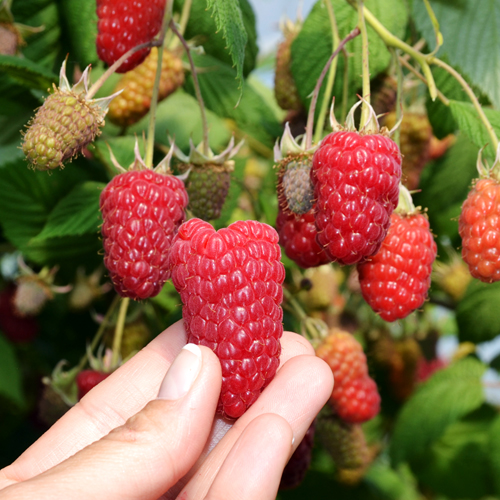
Description
Przehyba is a Polish licensed summer raspberry dessert variety. Fruiting on overwintered two-year-old shoots. Early ripening, begins to bear fruit a few days earlier Lyachki, and Sokolitsu ahead of the week. In the south, it begins to sing in early June. In Western, Central Ukraine and Poland in the open field, the collection begins in the third decade of June. In Central Russia since the beginning of July. This raspberry has already proven itself to be excellent when grown in greenhouses (in particular in tunnels). In Poland, the collection in tunnels starts from the 20th of May.
Pshekhiba has good vigor. Stems in the bush for the season grows on average 5-7 pieces. Shoots are tall, curved at the top, medium in thickness, with small purple thorns. The shoots are mostly 1.7-2.0 meters high, but grow up to 2.5 meters in greenhouses. Young stems are juicy green, rather densely studded. But with age, as the shoots grow, the number of thorns becomes insignificant. And the ripe shoots acquire a light brown color with an anthocyanin tint.
Laterals are numerous, strong, resilient, with sparse spines. They are medium and long, mostly 40-70 cm. They have up to 4 orders of branching. The root system is powerful, well-branched. The variety produces root shoots well. The leaves are large, corrugated, oval in shape with an elongated pointed nose. They are deep green in color, straight and slightly curled. The edges of the leaf are composed of sharp small teeth. Raspberries bloom amicably, profusely, starting in May.The flowers are large, white, collected in dense brushes.
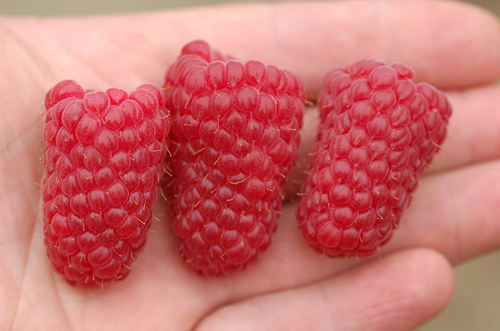
The fruits are very beautiful, one-dimensional, aligned, as if chiseled. The berries are intense, bright red in color with a glossy sheen and slight pubescence. When fully ripe, they become somewhat darker. The berries are large and very large, weighing from 7 to 12 grams in the season. They can be poured up to just a huge size of 14 grams. Moreover, the average weight of Pshekhiba berries is the largest for its class - 9.7 grams. Fruits are fleshy, wide, elongated, cylindrical and blunt-conical in shape. The average length of berries in the season is 3-5 cm, but some specimens can grow even larger than a matchbox. The skin is thin, but very firm and elastic.
Berries have a pleasant, dessert, really raspberry flavor. Sugar and acid are well balanced in them. Although Pshekhiba is insignificant in taste and sugar content, it loses to Lyachka and Sokolitsa. The berries of this raspberry have the highest concentration of anthocyanins (46.7 mg / 100 grams of fruit) of all Polish varieties that bear fruit on two-year-old shoots. The crop ripens in numerous clusters of 10-20 or more fruits. The berries are firm, firm, but the pulp is juicy, with small seeds inside. Has a pleasant raspberry aroma. Drupes are uniform, medium and small, tightly linked to each other. The fruits do not crumble when picked and do not rot after ripening on the bush, as well as during storage. Berries retain high commercial characteristics for a long time. Fruits for universal use, they are excellent for fresh consumption, direct sales in the markets of fresh berries, freezing, drying and all types of processing (jams, marshmallows, marmalades, syrups, sweet sauces). The variety is great for both hobbyist and industrial cultivation.
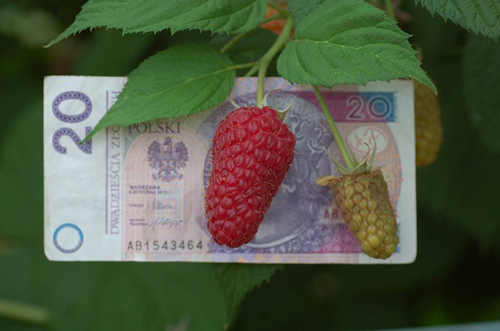
Pshekhiba is distinguished by a very amicable ripening of fruits, which certainly makes mechanical harvesting possible. It is characterized as a commercial dessert variety that consistently produces a large percentage of large, even and one-dimensional fruits in the season. The crop has excellent keeping quality and transportability. Especially with proper cooling of fruits and using shallow containers, for example, plastic booties or small cardboard boxes. Berries are resistant to mechanical damage during collection, transportation and storage.
This raspberry has a lot of potential. Productivity at a high and very high level, 20.0−35.0 t / ha. It directly depends on the agricultural technology used and, of course, on the planting scheme itself (how many plants will be planted on the same area). The yield from a bush depends on the number of shoots left in it. From one full-fledged shoot, productivity comes out 1-1.4 kg, depending on the agricultural technology used and growing conditions.
Pshekhiba has a very high resistance to major diseases and pests of raspberries. And also the already proven high frost resistance and resistance to freezing of buds on the stem. It also has good heat and drought resistance. But for high commercial characteristics of the fruit, of course, you need a regular supply of moisture. Especially when the berries ripen and directly during fruiting. Our heroine responds well to the introduction of fertilizers, and especially organic matter in the soil. The rate of application of rotted manure is 40-50 t / ha or 400-500 kg / weaving.
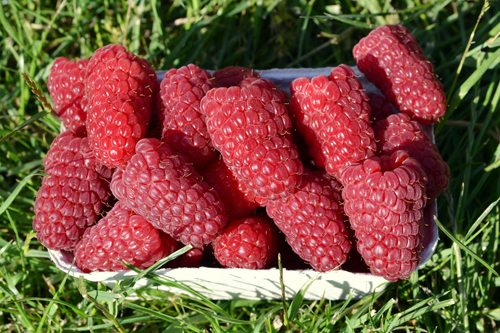
There is an interesting 2016 report on an experiment conducted at the farm of Dr. Pavel Kravets, Poland, better known as the Malinowe Factory project. It is the best and most famous collection of different varieties of raspberries in Europe, grown in tunnels for scientific purposes. Cultivation is carried out with the aim of testing growing technologies, optimizing protection and feeding systems, obtaining maximum yields and the best quality berries.
The project was founded in 2015.The plantation was planted in June / July. Used seedlings in vitro with a closed root system, in pots. In addition to 13 remontant varieties, 4 summer varieties were also selected for the experiment. The planting pattern for summer varieties is 3.5 meters between rows and 40 cm between plants in a row.
| Variety name | Lyachka | Radzieva | Falcon | Pshekhiba |
| Harvest from one shoot, kg | 1,0 | 1,2 | 1,7 | 1,4 |
| Harvest per plant, kg | 1,8 | 2,2 | 3,4 | 2,6 |
| Harvest per hectare, t | 13,6 | 16,5 | 25,0 | 19,0 |
| Average fetal weight, g (min-max) | 6,9 (4,9−8,3) | 7,7 (5,3−8,9) | 7,1 (4,4−8,6) | 9,7 (6,9−11,3) |
| Brix level,% | 10,5 | 10,1 | 10,4 | 9,7 |
(According to dr Paweł Krawiec, Uniwersytet Przyrodniczy w Lublinie / Horti Team)
As you can see from the table, Pshekhiba has the largest and highest quality berries in comparison with Lyachka, Radzieva and Sokolitsa. But Sokolitsa bypassed our heroine in terms of yield. Therefore, information from Polish farmers about a yield of 35.0 and even up to 40.0 t / ha is not a fairy tale, but a completely achievable reality. Provided that it is grown in greenhouses, high agricultural technology and planting of raspberries with a row spacing of 2 meters and a distance of 40 cm between plants in a row.
Strengths
- Highest quality and largest berries in their class.
- Fruits with harmoniously balanced sugar and acid, with a good raspberry flavor and aroma.
- Very high, stable yields. Pshekhiba has a very amicable ripening of fruits.
- Resistant to major diseases and pests of raspberries.
- High indicators of general frost resistance. Resistance to kidney freezing.
- Good heat and drought resistance.
- Weak thorny shoots with small thorns, good vigor of the bush.
- The versatility of the use of fruits (freezing, drying, processing, sale, fresh consumption).
- Its early ripening, fruit size and yield make it one of the best varieties for commercial berry production.
- After ripening, the fruits of Pshekhiba remain hanging on the bush, do not crumble or rot. Easy pull-off when picking, the berries do not crumble and do not flow.
- Excellent indicators of keeping quality and transportability, resistance to mechanical damage.
- The ability of raspberries to develop successfully and show high results both in open and protected ground.
Weak sides
- A sparse bush, the obligatory installation of trellises or supports is required.
- It is necessary to regularly cut out excess stems and twigs, carry out sanitary cleaning.
- Dessert taste, slightly inferior to other early Polish varieties.
- To maintain high yields and berry size, a high level of agricultural technology is required.
- Only in a few years will there be a clear picture of Pshekhiba in the conditions of our country. Including all types of raspberry resistance to negative factors, diseases and yield indicators by region.
Author: Maxim Zarechny.









Yes, heat resistance, pest resistance. I bought seedlings in Terre from Seryoga in April 2019. They grew a little, so aphids and a raspberry fly began to eat them. Weather for 30, the leaves are burning. I deliberately did not shade or spray the specials. protection from burns. Further time will tell, but it seems to me this is a scam for money, the price was like for Maravilla, whose mother plants were brought from England. It is not for nothing that she is not in the Father's Garden, at the Pavvskys.